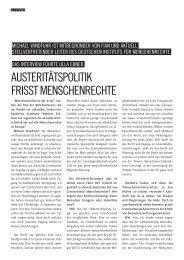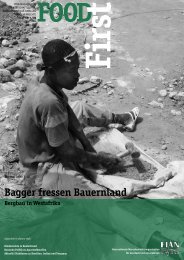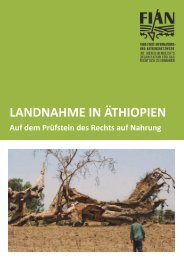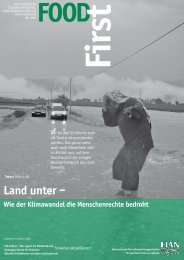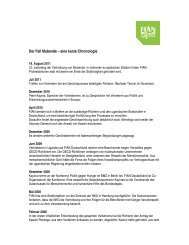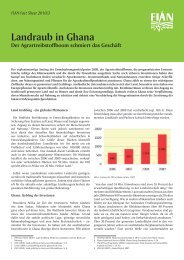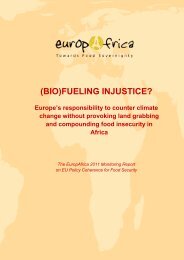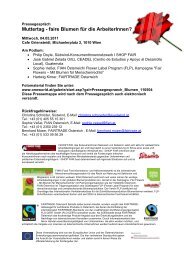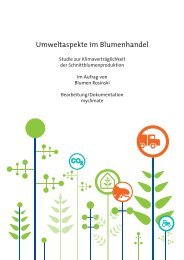Study 3: Ecodestruction and the Right to Food: The Cases of Water ...
Study 3: Ecodestruction and the Right to Food: The Cases of Water ...
Study 3: Ecodestruction and the Right to Food: The Cases of Water ...
You also want an ePaper? Increase the reach of your titles
YUMPU automatically turns print PDFs into web optimized ePapers that Google loves.
Starving <strong>the</strong> Future <strong>Study</strong> 3<br />
B. Violations <strong>of</strong> <strong>the</strong> <strong>Right</strong> <strong>to</strong> <strong>Food</strong> through <strong>the</strong> Destruction <strong>of</strong><br />
<strong>Water</strong> Resources<br />
<strong>Water</strong> quality is challenged by heavy pollution <strong>and</strong> contamination <strong>of</strong> ground water <strong>and</strong> rivers. In almost<br />
all regions, fresh water supplies are already threatened <strong>and</strong> overexploited. Human beings need fresh<br />
water as drinking water <strong>to</strong> survive, as resource <strong>to</strong> cook <strong>the</strong>ir food but also <strong>to</strong> produce <strong>the</strong>ir food<br />
(irrigation). <strong>The</strong>se are <strong>the</strong> basic <strong>and</strong> vital services provided by <strong>the</strong> ecosystem freshwater in relation <strong>to</strong><br />
<strong>the</strong> nutrition. As struggling for people ´s right <strong>to</strong> feed <strong>the</strong>mselves implied <strong>to</strong> intervene for <strong>the</strong> access <strong>to</strong><br />
<strong>and</strong> control <strong>of</strong> food producing resources, it is not rare <strong>to</strong> find a water component in FIAN interventions.<br />
L<strong>and</strong> <strong>and</strong> water as resources are intimately linked. Frequently, peasants who have been evicted from<br />
<strong>the</strong>ir l<strong>and</strong> have simultaneously lost <strong>the</strong>ir access <strong>to</strong> freshwater ei<strong>the</strong>r because people have <strong>to</strong> become<br />
dwellers in <strong>the</strong> poorest urban areas where <strong>the</strong>re is no access <strong>to</strong> drinking water or because <strong>the</strong>y have <strong>to</strong><br />
rely on public water distribution systems (<strong>the</strong>se situations are indeed <strong>of</strong>ten linked with a shift from a<br />
situation <strong>of</strong> a self-reliant community access <strong>to</strong> water <strong>to</strong> a dependent <strong>and</strong> paying access <strong>to</strong> water). In<br />
o<strong>the</strong>r cases, large industrial projects like hydroplants or dams for irrigation <strong>of</strong> big estates or water supply<br />
for <strong>the</strong> surrounding urban areas are implemented at <strong>the</strong> cost <strong>of</strong> small producers <strong>and</strong> <strong>the</strong> marginalized<br />
rural population. Finally, <strong>the</strong> analysis <strong>of</strong> FIAN Interventions shows that people do lose access <strong>to</strong> <strong>the</strong>ir<br />
water supply because <strong>the</strong>y cannot use it any longer due <strong>to</strong> attacks on <strong>the</strong> water quality. States failure <strong>to</strong><br />
s<strong>to</strong>p severe pollution through chemicals dumped or leaked in<strong>to</strong> <strong>the</strong> rivers on which <strong>the</strong> local population<br />
depends for fishing, drinking water <strong>and</strong> irritation, <strong>the</strong> right <strong>to</strong> feed <strong>the</strong>mselves <strong>of</strong> <strong>the</strong> concerned people is<br />
violated. <strong>The</strong> case <strong>of</strong> gold mining is an illustration <strong>of</strong> <strong>the</strong> link between destruction <strong>of</strong> freshwater<br />
ecosystems <strong>and</strong> violations <strong>of</strong> <strong>the</strong> right <strong>to</strong> adequate food.<br />
1. Pollution by gold mining: Pr<strong>of</strong>it for <strong>the</strong> few ... but at <strong>the</strong> expense <strong>of</strong> people<br />
<strong>and</strong> <strong>the</strong>ir environment.<br />
Gold has been a symbol for wealth <strong>and</strong> power – at least in <strong>the</strong> western world. Many wars, conquests,<br />
crimes <strong>and</strong> human rights violations have been due <strong>to</strong> appropriation <strong>and</strong> accumulation. 24 Today, gold for<br />
<strong>the</strong> international market allows <strong>to</strong> draw enormous pr<strong>of</strong>its. But gold mining does not prove <strong>to</strong> be in favour<br />
<strong>of</strong> <strong>the</strong> local population which has been living in <strong>the</strong> extraction area. First <strong>of</strong> all, many small peasants <strong>and</strong><br />
o<strong>the</strong>r vulnerable rural groups are forcibly evicted from <strong>the</strong>ir l<strong>and</strong>. <strong>The</strong>y lose <strong>the</strong>ir means <strong>of</strong> subsistence<br />
(including l<strong>and</strong> <strong>and</strong> water), which enabled <strong>the</strong>m <strong>to</strong> feed <strong>the</strong>mselves. <strong>The</strong> private company equipped with<br />
an extraction licence for <strong>the</strong> area rarely <strong>of</strong>fer adequate compensation <strong>to</strong> <strong>the</strong> people for <strong>the</strong> loss <strong>of</strong> <strong>the</strong>ir<br />
livelihoods. More <strong>of</strong>ten, pressure <strong>and</strong> harassment are preferred <strong>to</strong> negotiation <strong>and</strong> consultation. Second,<br />
this mining activity is highly polluting. In addition <strong>to</strong> <strong>the</strong> loss <strong>of</strong> <strong>to</strong>psoils due <strong>to</strong> <strong>the</strong> extraction itself, gold<br />
extraction need chemicals like cyanide or mercury. <strong>The</strong> use <strong>of</strong> those is paraded as an “efficient <strong>and</strong><br />
competitive” way <strong>to</strong> extract <strong>the</strong> ore – but freshwater systems are particularly affected by dumpings <strong>and</strong><br />
inadequate s<strong>to</strong>rage <strong>of</strong> contaminants <strong>and</strong> waste. Technologies based on <strong>the</strong> use <strong>of</strong> cyanide <strong>and</strong> mercury<br />
have make it pr<strong>of</strong>itable <strong>to</strong> extract gold even in areas <strong>of</strong> low quality ore, which has led <strong>to</strong> levelling whole<br />
mountains <strong>and</strong> destroying entire l<strong>and</strong>scapes. Figures for <strong>the</strong> year 1992 indicate that some 650 million<br />
<strong>to</strong>ns <strong>of</strong> waste were generated for <strong>the</strong> production <strong>of</strong> only 2,170 <strong>to</strong>ns <strong>of</strong> gold. 25<br />
Waste is sometimes simply dumped in rivers <strong>and</strong> lakes, infiltrates through soils in<strong>to</strong> groundwater<br />
aquifers. Waste is <strong>of</strong>ten s<strong>to</strong>red under inadequate conditions. Of course, <strong>the</strong>se techniques are mostly<br />
used by large mining companies. However, small-scale miners are also attracted by this method <strong>of</strong><br />
extracting gold even in difficult or poor mining areas. Currently a worrying trend is <strong>to</strong> be observed, i.e. a<br />
boom in mining <strong>and</strong> a diminution <strong>of</strong> st<strong>and</strong>ards for human rights <strong>and</strong> ecology. Encouraged by <strong>the</strong> World<br />
Bank, several African countries have “liberalized” or want <strong>to</strong> weaken <strong>the</strong>ir mining codes <strong>and</strong> legislation<br />
in favour <strong>of</strong> foreign inves<strong>to</strong>rs. <strong>The</strong> deregulation is frequently at <strong>the</strong> expense <strong>of</strong> human rights <strong>and</strong><br />
ecosystems, among <strong>the</strong>m freshwater.<br />
FIAN International 121<br />
June 2002



